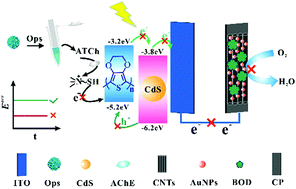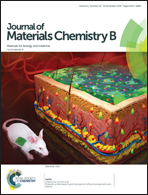Light-driven self-powered biosensor for ultrasensitive organophosphate pesticide detection via integration of the conjugated polymer-sensitized CdS and enzyme inhibition strategy†
Abstract
Herein, a light-driven self-powered biosensor based on a photoelectrochemical enzymatic fuel cell (PEFC) was proposed for ultrasensitive organophosphate pesticide (OP) detection. To construct this fuel cell, poly(3,4-ethylenedioxythiophene)-sensitized CdS quantum dot (PEDOT/CdS) photoanode and multiwalled carbon nanotubes/gold nanoparticals/bilirubin oxidase (CNTs/AuNPs/BOD) biocathode were elaborately designed. Initially, the enzyme acetylcholinesterase (AChE) immobilized on the CdS/PEDOT photoanode could hydrolyze acetylthiocholine iodide (ATCh) into thiocholine as the electron donor to enhance the charge separation efficiency; thus, PEFC produced relatively high open circuit voltage (EOCV) upon illumination. OPs could inhibit the AChE enzymatic catalytic activity on hydrolysis, and in this case, a smaller EOCV obtained. Thus, based on the constructed PEFC, self-powered biosensing of OPs was realized, and the detection limit was as low as 0.012 ng mL−1 (S/N = 3), which was comparable or superior to those of the reported methods. In this study, we not only constructed a facile, ultrasensitive and low-cost sensing platform for OP detection, but also provided an ingenious idea for designing light-driven self-powered biosensing based on PEFC.



 Please wait while we load your content...
Please wait while we load your content...